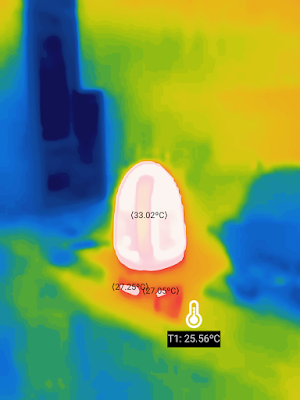I am pleased to announce Project Snake Eyes. This ambitious project aims to combine image analysis and infrared imaging to create biomimetic thermal vision — computer vision that simulates the ability of some animals such as snakes to see in darkness. One of the goals of Project Snake Eyes is to create probably the world’s first robotic snake that can hunt through thermal sensing. Project Snake Eyes not only can detect heat, but it can also estimate the size and proximity of the source, giving the robotic snake the artificial intelligence to figure out whether or not it should strike the target. Through two weeks of intense research and development, I have come up with original algorithms that allow robust automatic feature extraction in real time from thermal images through a FLIR ONE camera. This article reports my progress thus far. The algorithms will be published in a journal in the field of image processing and computer vision later.
Figure 1 shows the detection of windows at night from outside a house. Half of the window was open at the time of observation. The lower temperature of the upper pane was partially due to the reflection of infrared light from the cooler environment such as the sky by the glass. The lower pane, which was the open part of the window, was due to the warmer inside of the house. As you can see, Project Snake Eyes approximately identified the shapes and sizes of the two panes, which stood out from the background because of their distinct temperatures. This ability will be used to develop advanced algorithms to automatically analyze the thermal signature of a building, paving the road to large-scale building thermal analyses through automation.
Figure 2 shows a more complex scenario using my computer desk as an example. As you can see, Project Snake Eyes automatically detected most of the hot spots (or cold spots, but I use hot spots to represent points of interest at either high or low temperature). Feature extraction such as blob detection through thermal vision could result in enhanced computer vision for technologies such as unmanned vehicles.
Figure 3 shows object reconstruction based on residue heat using my hand as an example. The residue heat that my hand left on the wall revealed its shape as six separate polygons (the largest one corresponds to the palm and the five smaller ones to the fingertips). Object reconstruction through residue heat could find its applications in certain industry monitoring and control.
 |
| Project Snake Eyes aims to identify and track objects. |
Figure 4 shows object tracking using a colleague as an example. As you can see, Project Snake Eyes basically captured his body shape. The video clip that follows shows how this works in real time. The algorithms still need optimization to reduce the lag, but you get the basic idea of how object tracking using Project Snake Eyes works. Object tracking will be used to realize animal and human tracking in dark conditions for many science and engineering applications. For instance, we are collaborating with biologists in Texas to develop a system that can track bats at night in order to monitor the health of their colonies.
With all these excitements, I expect to carry on the research and development of Project Snake Eyes in the coming years. As a landmark step, we are working tirelessly towards the unveiling of the first prototype of the robotic snake with thermal vision, collaborating with two robotics teams led by Prof. Yan Gu at the University of Massachusetts Lowell and Prof. Zhenghui Sha at the University of Arkansas, respectively.
Stay tuned!
